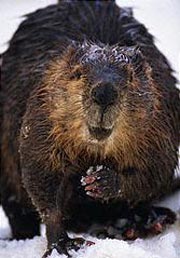
Plan to Reintroduce Beavers to Scotland Faces Opposition
By Paul Kelbie in the Independent 8 th January 2002
 More than 400 years after beavers were hunted to extinction in Britain, they could soon be back - in the Highlands.
More than 400 years after beavers were hunted to extinction in Britain, they could soon be back - in the Highlands.
Scottish Natural Heritage will ask the Scottish Executive next month for permission to import a colony of beavers from Norway. The ecology organization wants to release them into the wild as part of a reintroduction scheme. The first beavers could arrive in Britain by autumn and would be released after six months in quarantine.
The project has caused consternation among farmers, landowners, and residents of Argyll on whose doorstep the animals are to be released. Up to 18 of the animals are expected to be tagged and monitored after they are set free in the Knapdale Forest, much to the annoyance of locals who fear the risk of disease and the possible environmental and economic damage.
"Beavers are a destructive pest and that's why they were killed 400 years ago," said Robin Malcolm, who owns a 5,000-acre (2,000-hectare) farm adjacent to the proposed trial site. "They are destructive to agriculture, forestry, and fisheries. This is not, despite what Scottish Natural Heritage claim, a reintroduction of a species but the imposition of an alien species on the Highlands of Scotland."
Plan Engenders Controversy
Malcolm, who was for five years a regional board member of Scottish Natural Heritage, said beavers had usually been found in the south of England.
"My research into the historical evidence has identified their heartland as being south of the line joining the Severn to the Wash," he said. "They are a south of England creature and if you follow the remains north you'll find there was an enclave in Humberside and only six recorded cases in Scotland, of which three were in Berwickshire. There have been no such discoveries in the Highlands."
Malcolm said beavers could spread giardiasis, a disease that damages the immune system. "It's known in the United States as beaver fever. Although not fatal in itself, it can be quite nasty."
But Nancy Fraser of Scottish Natural Heritage denied the beavers would cause problems. "They don't spread disease to man. This is scaremongering by a few individuals who are trying to scupper this project.
"Opponents have claimed that if beavers were reintroduced, Argyll would become a Giardia blackspot, forcing tourists to stay away to the enormous detriment of the local economy. That is nonsense. Giardia is already present in Scotland, carried by animals like deer. Besides, the beavers will be in quarantine for six months."
Environmental Concerns Expressed
Landowners and the National Farmers' Union of Scotland believe the animals could damage the environment and industry.
"In Bavaria on the upper Danube, beavers have caused immense problems for hydroelectric industries costing millions of pounds a year," said Malcolm. "Beavers are such clever water engineers that when the snows are melting on the Alps there's no problem, but in the summer getting enough water to push through the turbines is difficult. Each beaver colony needs something like a hectare (2.5 acres) of water of a certain depth.
"If it was a proper reintroduction these animals would be released in the Thames Valley, but there would be such an outrage from people with extended gardens, cherished trees, and waterways they would never get away with it," he said.
Fraser denied the beavers would cause devastation. "We carried out considerable research to make sure there was still an ecological niche for beavers in Scotland. They are a missing element of our natural heritage and we are responsible for their extinction. We have fossil evidence and written historical records of beavers in the Highlands around Inverness, Lochaber, and as far north as Caithness.
"We are doing our absolute best to take on people's concerns but they have to remember this is only a trial scheme. If it is a disaster we will stop and abandon any plans to introduce beavers back into the country."
© The Independent, 8 th January 2002
 |
 |
 |
| Return to index | Return to Exotic Scottish Animals | Return to European Beaver |